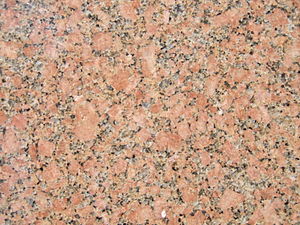| Igneous rock | |
 | |
| Composition | |
|---|---|
| Classification | Felsic |
| Primary | potassium feldspar, plagioclase feldspar, and quartz |
| Secondary | Differing amounts of muscovite, biotite, and hornblende-type amphiboles |
Granite (/ˈɡrænɪt/ GRAN-it) is a coarse-grained (phaneritic) intrusive igneous rock composed mostly of quartz, alkali feldspar, and plagioclase. It forms from magma with a high content of silica and alkali metal oxides that slowly cools and solidifies underground. It is common in the continental crust of Earth, where it is found in igneous intrusions. These range in size from dikes only a few centimeters across to batholiths exposed over hundreds of square kilometers.
Granite is typical of a larger family of granitic rocks, or granitoids, that are composed mostly of coarse-grained quartz and feldspars in varying proportions. These rocks are classified by the relative percentages of quartz, alkali feldspar, and plagioclase (the QAPF classification), with true granite representing granitic rocks rich in quartz and alkali feldspar. Most granitic rocks also contain mica or amphibole minerals, though a few (known as leucogranites) contain almost no dark minerals.

Granite is nearly always massive (lacking any internal structures), hard (falling between 6 and 7 on the Mohs hardness scale)[specify], and tough. These properties have made granite a widespread construction stone throughout human history.